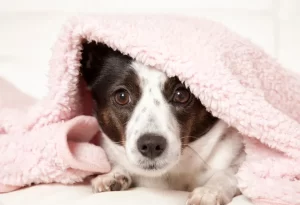
By Uchenna C. Okeke
Natural disasters like floods, winter storms, hurricanes and tropical storms can be overwhelming. Our companion animals depend entirely on us for protection in times of crisis so we must be prepared to handle the situation before, during and after it occurs. Different disasters pose unique risks, so knowing how to protect your pet in each situation is important. Let’s explore the steps you can take to keep your pet safe.
BEFORE
Know Where to Go Before You Have to Leave
It’s important to have an evacuation plan that includes your pet. Research nearby pet-friendly shelters, hotels, or safe places ahead of time, as not all shelters accept animals. Keep a list of veterinary clinics, animal shelters, or friends who can help if needed. Advance planning helps you act quickly and avoid last-minute stress.
Pack a Pet Emergency Kit
Just as you prepare an emergency kit for yourself, it’s vital to have one for your pet. Your pet’s kit should include:
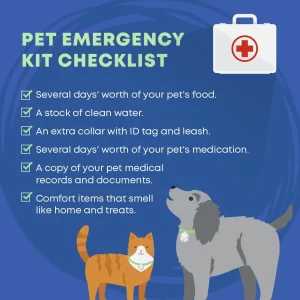
Ensure Proper Identification
Disasters can separate pets from their owners, making identification vital. Ensure your dog wears a secure collar with an updated ID tag. All pets should be microchipped with your current contact details as this greatly increases the chances of being reunited if you become separated.
DURING
Evacuate Safely
Disaster conditions can worsen quickly, so keep your pet in a secure carrier or on a leash at all times to prevent them from running away in fear. If evacuating by car, ensure they are safely restrained to prevent panic-driven escape attempts.
Keep Your Pet Calm in the Chaos
Pets pick up on human emotions, so staying as calm as possible will help reassure them. If you’re sheltering in place, keep your pet in a safe, enclosed area away from windows, loud noises, and dangerous objects. Provide comfort with familiar items, speak soothingly and avoid sudden movements to help ease their anxiety.
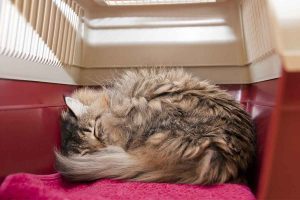
AFTER
After the disaster, your pet may still face health risks like injuries, dehydration, or emotional distress.
Check for injuries
Inspect your pet for cuts, burns, or breathing difficulties. Seek veterinary care if needed.
Provide a stable routine
Keeping their food, sleeping, and play schedules consistent helps them feel secure.
Watch for behavioral changes
Some pets may become anxious or fearful after a traumatic event. Be patient. Pets, like humans, need time to heal after trauma.
Protecting Pets in Specific Situations
Floods
If you live in a flood-prone area, plan evacuation routes in advance. During a flood, keep pets indoors in an elevated, safe space. If evacuating, use a secure carrier or leash and move to higher ground. After the flood, check for mold, toxic chemicals, and sharp debris that could harm your pet.
Winter Storms
Winter storms bring cold, snow, and ice that can harm pets. Keep them indoors in a warm, dry area. If they go outside, limit their time in the cold, wipe their paws, and use a coat or booties if needed. Stock up on food, water, and supplies in case of power outages, and be ready to evacuate if needed. For more information, read 12 Cold Weather Safety Tips.

Hurricanes/Tropical Storms
Strong winds and flying debris pose serious risks. Keep your pet in a secure room, away from windows and unstable furniture. If evacuating, transport them in a sturdy carrier or on a leash. After the storm, inspect the area for hazards before allowing them outside.
Conclusion
Natural disasters can be traumatic for pets as they are for humans. Unlike us, pets don’t understand what’s happening—they simply sense the fear, chaos, and sudden changes. In those critical moments, every second counts and with the right preparation, you can protect yourself and loved ones, including your pet. Always remember that when disaster comes, being ready can make all the difference.
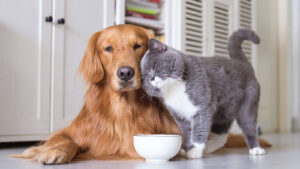
By Uchenna C. Okeke
When it comes to our homes, safety is paramount. However, for pets, the definition of safety can be vastly different. What may seem harmless to humans can pose significant risks to companion animals. Pet-proofing is essential to ensure your home is a haven, not a hazard. Here are steps to pet-proofing your home.
STEP 1- Understanding Your Pet’s World
The first step is to observe your pet’s behavior and habits to anticipate potential risks. Pets use their senses to discover hidden dangers. For example, Anne Senft, HSLC Board President, fostered a blind cat that relied on memory and touch to navigate. “We were told not to move any furniture because he would ‘map’ out the basement like a robot vacuum,” she relates. This experience shows the importance of consistency in your pet’s environment.
Before bringing a pet home or making changes to their environment, identify areas where curiosity and instinct may lead them astray. Consider the factors that drive their actions, including their natural instincts to sniff, chew and investigate, and physical abilities that enable them to climb and jump.
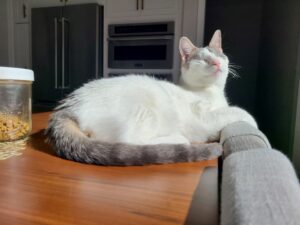
STEP 2- Room-by-Room Checklist
Conduct a thorough examination of each room to remove hazards and ensure safety.
- Living Room: Secure wires and cords, move toxic plants out of reach, and anchor heavy furniture to prevent tipping.
- Kitchen: Store food and cleaning supplies safely, block access to countertops and appliances and clean up crumbs and spills promptly.
- Bathroom: Keep toilet paper and towels out of reach, secure bathroom trash cans, and store medications and cosmetics safely.
- Bedrooms: Organize shoes and clothing, store electrical cords and devices and block access to closets and drawers.
STEP 3- Identify Hidden Dangers
Hidden dangers are often-overlooked areas that can pose significant risks to your pet’s safety. These include:
- Electrical outlets
- Toxic substances
- Choking hazards
- Fall risks

STEP 4- Assess Pet-Specific Needs
Consider your pet’s unique characteristics, such as age, size, breed, and abilities, to tailor your pet-proofing strategy. For example:
- As noted above, blind pets require consistent furniture arrangements to help them navigate through memory and touch.
- Senior pets need easy access to essentials like food, water, litter, and favorite resting spots to accommodate their reduced mobility and potential health issues.
- Puppies need to have secure environments, including blocked off areas and secured toxic substances which will help to protect their curiosity-driven nature and rapid growth.
- Small pets require secure enclosures and protected electrical wires to prevent escape and electrical shock.
- Large pets need reinforced furniture and secured heavy objects to prevent accidents and damage.
- Pets with medical conditions may need adaptations to accommodate specific health needs, such as easy-to-clean surfaces for pets with allergies.
STEP 5- Creating a Pet-Friendly Home
Creating a pet-friendly environment enhances overall well-being. Consider:
- Designating pet zones for rest and relaxation. Create cozy areas where your pet can retreat for calm and rejuvenation. This helps reduce stress and provides a sense of security.
- Choosing durable, easy-to-clean surfaces. Select durable, easy-to-clean surfaces. Hardwood, tile, waterproof furniture, and washable walls make cleaning easy, keeping your home and pet healthy.
- Supervising and interacting with your pet. Spend quality time with your pet through play, exercise, and mental stimulation. This strengthens your bond, promoting a happy and healthy pet.
Remember pet-proofing is not just about removing dangers; it is also about creating an environment that promotes well-being. Ensure your furry friends’ safety and well-being today!
Ready to take the next steps? Visit the Humane Society of Loudon County (HSLC) to check out available animals for adoption and access valuable resources and tips.

By Carly Sanders
It’s no secret that animals like food. Some animals really like food, and most dogs and cats fall under that category. When you’ve got a pet that’s quick to scarf down scraps and isn’t too picky about what they’re made of, it’s important to know what is and isn’t safe.
Even pets who aren’t big eaters can still be at risk. Some harmful compounds can enter their bloodstream through contact with their skin, so it’s important to be aware of all products that you bring into your home that your animals may have access to.
Here at the Humane Society of Loudoun County, we want to help owners keep their beloved pets safe. Knowing about potential dangers around the house is a big part of that. By now, most of us have heard that things like chocolate and grapes are not safe for dogs, and it’s pretty common knowledge amongst cat owners that lilies can be harmful to cats. But did you know about these five lesser-known hazards?
Raw bread dough
There’s nothing like home-baked bread. While most humans prefer it after coming out of the oven, our animals are often less discerning. Make sure to keep that pizza dough far away from your pets, as dough containing yeast can continue to expand in the stomach after swallowing. This can lead to stomach stretching, a condition that can be fatal in severe cases.
Not only that, but as yeast ferments, it produces alcohol which can lead to alcohol poisoning.
Cooked bones
This one may seem surprising, but if you’re going to throw your dog (or cat!) a bone, make sure it’s a raw bone specifically meant for chewing. Cooked bones are more brittle than raw and can splinter more easily when broken by your pet’s teeth. When swallowed, sharp fragments can cause damage to the digestive tract.
If your pet loves the smell of fried chicken as much as my dog does, make sure to pay special attention and don’t leave that bucket unguarded!
Essential oils
Sniffing that bottle of tea tree oil might improve your headache, but keep it away from your pets, please! Many common plant-based essential oils, including tea tree oil, are toxic to cats and dogs. Other examples include wintergreen oil, eucalyptus oil, pine oil, and pennyroyal oil. These oils are harmful to cats and dogs when eaten and when applied to the skin.
Effects vary depending on the type of oil and the amount ingested. Symptoms range from stomach upset in mild cases to seizures and liver failure in more severe cases.

Rogaine
If you’re treating hair loss with the topical product Rogaine, take care to keep it away from anywhere your pets might like to hang out. Minoxidil, the active ingredient in Rogaine, is highly toxic to cats and dogs. Exposure can cause a dangerous drop in blood pressure for our four-legged friends.
Like with essential oils, Rogaine can affect your pet both through eating and through application to the skin. Many reported cases involve cats licking someone’s hand or head where the product was applied. Even small amounts can be harmful, with many reported cases involving only a few drops or licks worth of the product.
If you’re using any products containing minoxidil, be very careful to keep the product itself far away from your pets and take extra precautions to wash residue from your hands and any surfaces that they might come in contact with.
Xylitol
Xylitol, a common artificial sweetener, is highly toxic to dogs. Xylitol is found in many sugar-free food products and chewing gums, but it can also turn up in household products such as vitamins and toothpaste.
When it comes to cats, research is less plentiful. Serious side effects appear to be less common in felines, but more studies are needed. For now, we recommend playing it safe by keeping the ingredient away from pets of all varieties.
As for dogs, it’s well documented that xylitol causes severe low blood sugar, even in small doses. Higher doses can cause acute liver failure. Make sure to check for the ingredient in any new products you bring into your home, and pay special attention to anything labeled sugar-free or reduced sugar.
If you have reason to believe that your pet has been affected by any of these hazards, contact your emergency vet immediately to seek treatment. Knowing what to look for is the first step in protecting your loved ones, animals included! Make sure to be aware of what you or others are bringing into your home, and take precautions to keep anything potentially harmful far out of your curious companions’ reach.
